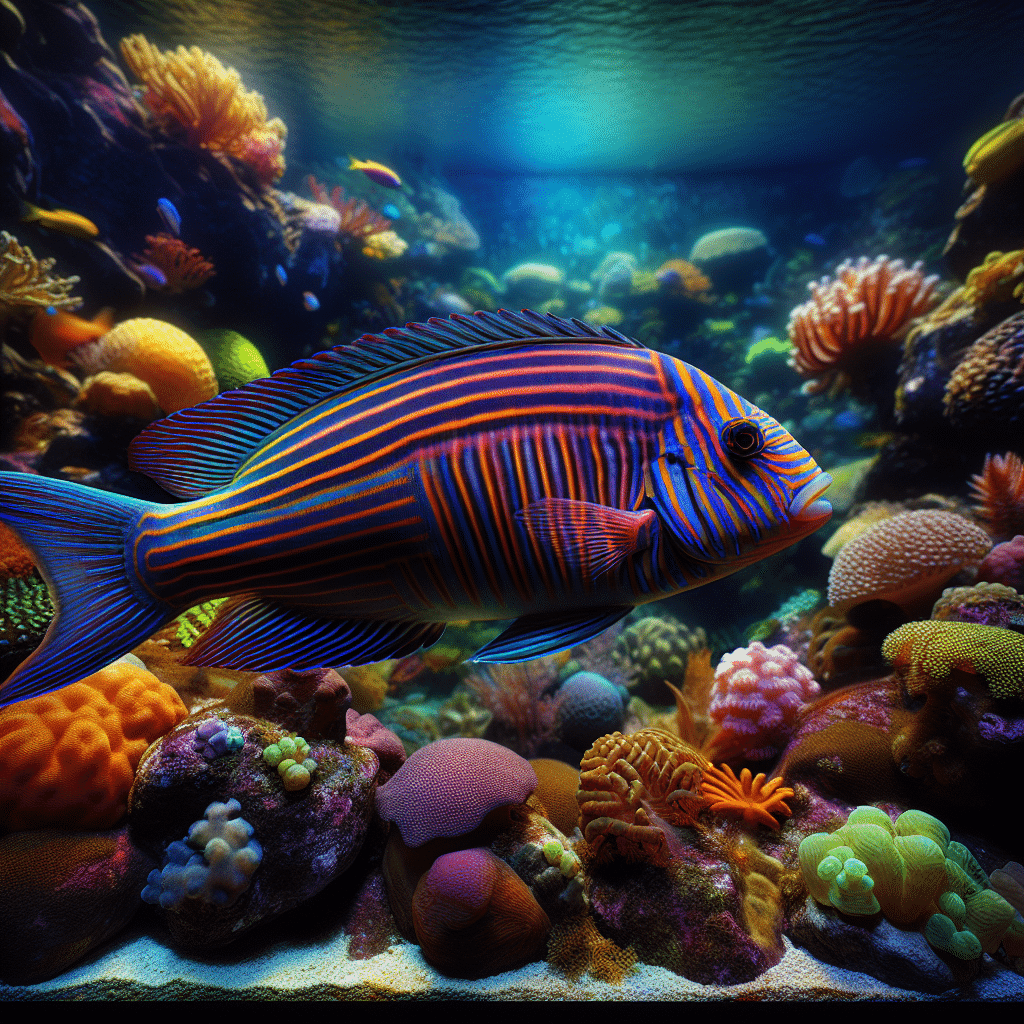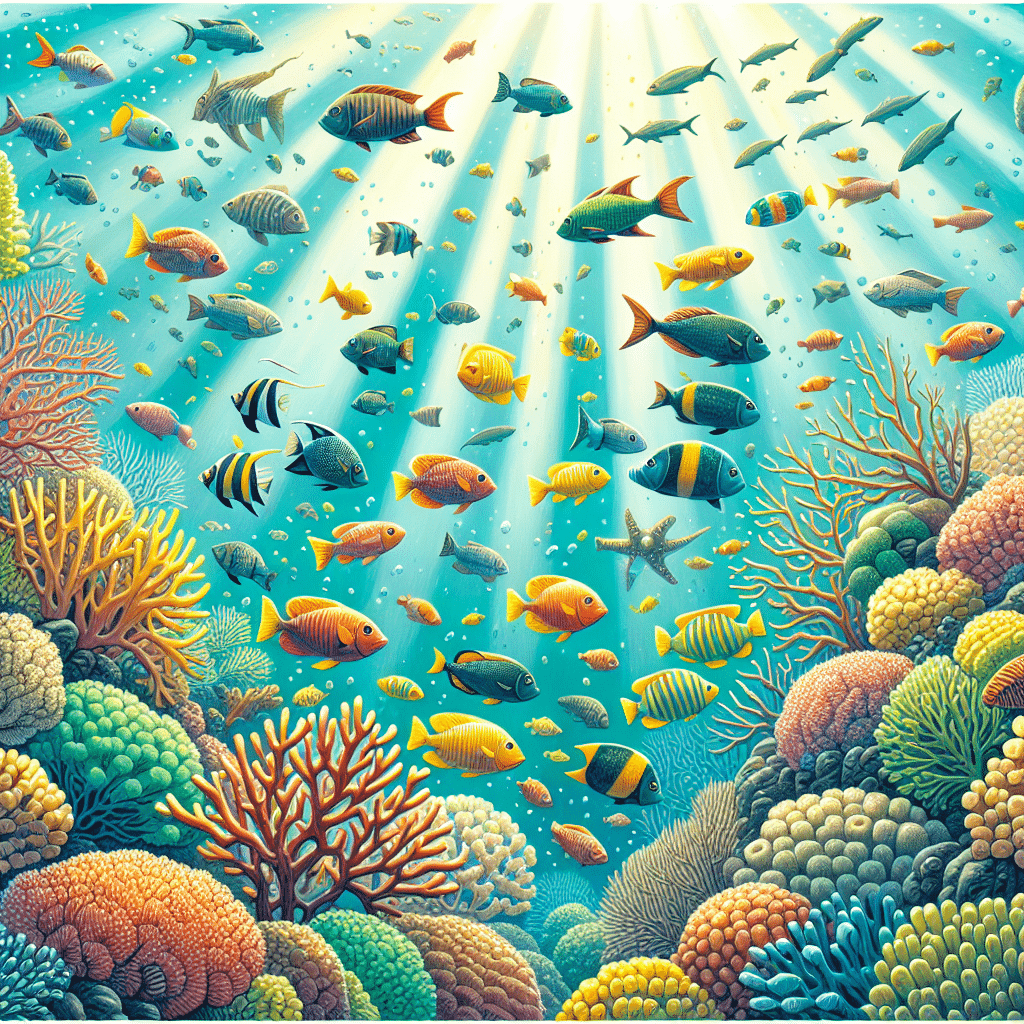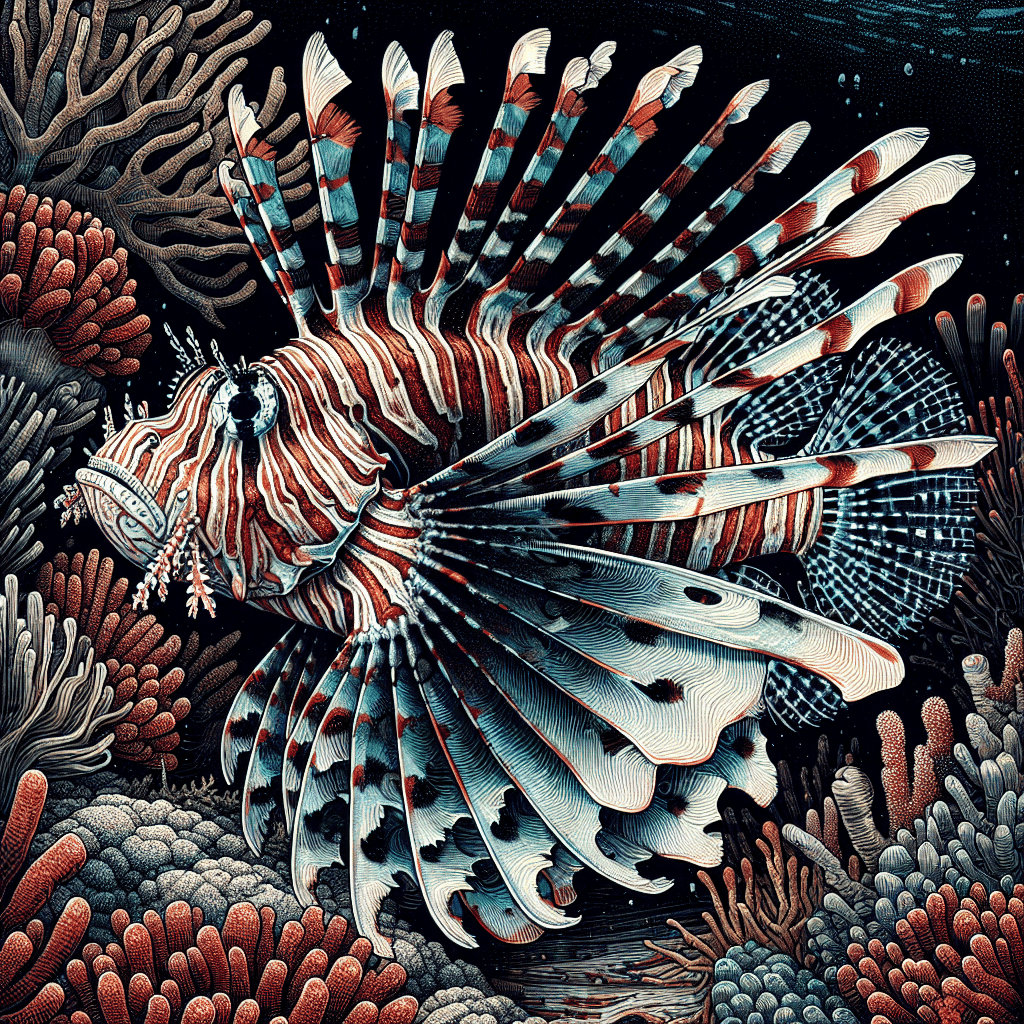Exploring Six Line Wrasse
Characteristics and Appearance
The Six Line Wrasse, scientifically known as Pseudocheilinus hexataenia, is a vibrant fish that catches the eye with its unique coloration. I’ve noticed that these fish are primarily purplish in color adorned with six striking orange stripes running along their bodies. They also have an orange cheek sprinkled with tiny yellow dots, which adds to their charm. The caudal fin and caudal peduncle are a beautiful green, and there’s a blue-edged black ocellus located on the upper caudal peduncle, making them quite distinctive.
| Feature | Description |
|---|---|
| Color | Purplish with six orange stripes |
| Cheek | Orange with tiny yellow dots |
| Caudal Fin | Green |
| Ocellus | Blue-edged black on upper caudal peduncle |
These visual traits make the Six Line Wrasse not only a popular choice among aquarists but also an interesting species to observe in a reef tank setting.
Natural Habitat and Distribution
The Six Line Wrasse originates from the warm tropical waters of the Indo-West and Central Pacific. They can be found in regions stretching from the Red Sea and all the way down to northern New South Wales in Australia. I find it fascinating that they prefer to inhabit protective coral reefs at depths of up to 20 meters.
The typical range of the Six Line Wrasse includes:
| Region | Notable Locations |
|---|---|
| Indo-Pacific | Red Sea, Great Barrier Reef, Fiji, northern Australia, Tuamotu |
| Depth | Up to 20 meters in coral reefs |
They thrive in coral reefs where they spend their days hunting small prey animals hiding in the cracks and crevices of the reef. The abundance of this species in their natural habitat contributes to their popularity in the aquarium trade, where they are typically wild-caught.
Understanding their natural habitat not only helps in replicating the right conditions in a tank but also enhances my appreciation for these beautiful fish.
Six Line Wrasse Care Guide
Caring for a six line wrasse is an adventure that brings a splash of color and personality to any reef tank. Here’s what I’ve learned about their care, feeding habits, and behavior compatibility.
Tank Size and Environment
When setting up a home for a six line wrasse, I make sure to provide adequate space and a suitable environment. Ideally, a tank size of at least 30 gallons is recommended. This size allows enough room for swimming and exploring. Six line wrasses thrive in environments that mimic their natural habitat, so I include plenty of hiding spots, caves, and live rock.
| Feature | Recommendation |
|---|---|
| Minimum Tank Size | 30 gallons |
| Hiding Spots | Caves and live rock |
| Environment | Mimic natural reef conditions |
They love to dart in and out of the rocks, making it essential to create a layout that offers both shelter and open swimming areas.
Feeding Habits
Feeding my six line wrasse is an enjoyable experience as they are not picky eaters. Their diet primarily consists of benthic invertebrates found in live rock, such as pyramidellid snails and commensal flatworms. To keep them healthy and vibrant, I supplement their diet with frozen foods like mysis and brine shrimp, along with regular flake and pellet foods.
| Food Type | Description |
|---|---|
| Benthic Invertebrates | Pyramidellid snails, commensal flatworms |
| Frozen Foods | Mysis, brine shrimp |
| Dry Foods | Flake and pellet foods |
I find that a varied diet helps maintain their health and coloration.
Behavior and Compatibility
One thing to note about six line wrasses is their temperament. They can be aggressive and territorial towards other fish, so I always consider their compatibility with tank mates. I typically choose large, confident, semi-aggressive fish, such as angelfish, banana wrasses, and butterflyfish.
| Behavior | Compatibility |
|---|---|
| Aggressive | Yes |
| Territorial | Yes |
| Suitable Tank Mates | Angelfish, banana wrasses, butterflyfish |
While they are generally reef safe, I avoid keeping them with small shrimp or very small fish, as these might become prey. For more information on compatible species, I recommend checking out the section on marine fish.
Taking these factors into account will ensure that my six line wrasse thrives in its aquarium home.
Breeding and Reproduction
Sexual Dimorphism
When it comes to the six line wrasse, I find it fascinating how the males and females differ in appearance. Adult males are generally larger than females, and their colors become more vibrant when they are ready to mate. This sexual dimorphism helps hobbyists like me identify males for breeding purposes.
| Feature | Male Six Line Wrasse | Female Six Line Wrasse |
|---|---|---|
| Size | Larger | Smaller |
| Coloration | More vibrant | Duller |
Spawning Behavior
Spawning behavior in six line wrasses is quite unique and interesting. These fish are known to spawn just before sunset. Paired adults dash towards the surface to quickly release their eggs and sperm, which reduces the risk of predation by other fish during this vulnerable time (Wikipedia).
The six line wrasse typically reproduces externally, meaning that the male’s sperm fertilizes the female’s eggs outside her body. This process is fascinating, especially considering that six line wrasses are protogynous hermaphrodites, which means they can change sex as they mature (Facts and Details).
While I enjoy observing their behaviors, it’s essential to note that these fish have not been successfully bred in captivity. They thrive in their natural habitat, where they are plentiful, and their breeding habits are likely influenced by environmental factors unique to their ecosystems.
For more details on caring for fish in a reef tank, check out our section on marine fish.
Unique Features of Six Line Wrasse
The six line wrasse is a fascinating fish that boasts several unique characteristics. These features not only enhance its beauty but also play important roles in its survival and behavior. Here are some of the standout traits that make the six line wrasse special.
Mucus Cocoon for Protection
One of the most intriguing behaviors of the six line wrasse is its ability to create a mucus cocoon while it sleeps at night. This diurnal species hides in cavities and secretes a protective layer of mucus around itself. This cocoon is believed to help shield the fish from nocturnal predators by masking its scent. It’s a clever adaptation that adds an extra layer of defense against potential threats (Wikipedia).
False Eye Spot
The six line wrasse features a unique “false eye” on its back fin. This distinctive marking is designed to confuse potential predators. By diverting the attention of a predator towards the false eye, the fish increases its chances of escaping an attack. The combination of its vibrant coloration and this clever adaptation makes the six line wrasse both visually striking and strategically savvy (Who Gives a Fish).
Cleaning Behavior
Another remarkable trait of the six line wrasse is its cleaning behavior. This fish is known for its pest control abilities, as it feeds on unwanted pests like pyramidellid snails, flatworms, and bristle worms. Additionally, it helps maintain the health of other fish in the tank by cleaning parasitic copepods and isopods from their fins and bodies. This mutualistic relationship not only benefits the six line wrasse but also enhances the overall health of the aquarium community (Who Gives a Fish).
The unique features of the six line wrasse contribute to its allure in the aquarium trade. Its fascinating behaviors and adaptations make it a captivating addition to any reef tank setup. For more information on caring for this species, check out our articles on marine fish and other popular tank mates like clownfish and tang.
Popularity and Availability
Aquarium Trade
I’ve found that the six-line wrasse is one of the most sought-after saltwater aquarium fish. This popularity stems from its vibrant colors, ease of care, and suitability for reef tanks, making it perfect for beginners in the hobby. Many fish shops stock them regularly, and they often become an impulse purchase due to their attractive appearance. They are known for being hardy little fish, with a long lifespan and a strong resistance to disease, which adds to their appeal in the marine fish community. Most six-line wrasses available in the market are wild-caught, as breeding them in captivity is nearly impossible (Fishkeeping World).
Price Range and Accessibility
In terms of pricing, the average cost of a single six-line wrasse typically ranges from $30 to $40, which is quite reasonable considering the benefits they bring to a reef setup (Fishkeeping World). Their accessibility makes them a great choice for hobbyists who want to add a splash of color to their tanks without breaking the bank. To create a thriving environment for my six-line wrasse, I ensure that I have a tank of at least 30 gallons, with plenty of hiding spots and live rock to mimic their natural habitat (FantaSEA Aquariums).
Here’s a quick summary of their availability and price:
| Attribute | Details |
|---|---|
| Average Price | $30 – $40 |
| Breeding | Wild-caught |
| Common in Shops | Yes |
| Recommended Tank Size | 30 gallons minimum |
| Lifespan | 4 – 6 years |
With such a combination of vibrant colors, manageable care requirements, and affordability, the six-line wrasse is a fantastic addition to any reef tank. If you’re considering other fish to pair with it, you might want to explore options like clownfish or tang for a well-rounded aquatic environment.
Notable Traits of Six Line Wrasse
The Six Line Wrasse is not just a pretty face in the reef tank; it also comes with some notable traits that make it a favorite among aquarium enthusiasts like me. Let’s dive into its pest control abilities and unique coloration.
Pest Control Abilities
One of the standout features of the Six Line Wrasse is its excellent pest control capabilities. This fish has a natural knack for keeping tank nuisances at bay. Once established in the tank, they actively hunt down and consume various pests, including pyramidellid snails, flatworms, and bristle worms. They also have a taste for parasitic copepods and isopods that can cling to the fins and bodies of other fish (Who Gives a Fish).
This makes them particularly beneficial in maintaining the health of the tank ecosystem. They are carnivorous and thrive on a diet that includes fish eggs, crab larvae, and small crustaceans. Feeding them twice a day ensures they stay healthy and continue their pest control duties effectively. A well-established tank with live rock provides them with plenty of microfauna to pick at, which is great for their diet.
| Pest Type | Consumed by Six Line Wrasse |
|---|---|
| Pyramidellid Snails | Yes |
| Flatworms | Yes |
| Bristle Worms | Yes |
| Copepods | Yes |
| Isopods | Yes |
Coloration and Patterns
The Six Line Wrasse is hard to miss with its stunning appearance. This fish boasts a beautiful bluish-purple to pink body adorned with six bright orange stripes. It’s got a unique twist with two lines that run right through its striking red eyes. This “false eye” feature is an evolutionary trait that helps confuse predators, making it harder for them to target the fish.
The fins of the Six Line Wrasse are generally clear or a translucent yellow, adding a delicate touch to its overall look. Its vibrant coloration and patterns not only make it a visually engaging addition to any reef tank but also enhance the aesthetic appeal of the aquarium.
In summary, the Six Line Wrasse is not just another fish; it’s a vibrant, resilient, and effective pest controller. Its beauty and utility make it a worthy addition to any saltwater aquarium. For more information on other marine fish that can complement your reef tank, check out our sections on marine fish and specific species like clownfish or tang.
Interactions and Tank Mates
Aggressiveness Towards Other Fish
When it comes to the six line wrasse, I’ve found that they are quite aggressive and territorial fish. They tend to be protective of their space, especially in a tank setting. This behavior can sometimes lead to conflicts with other fish. It’s important to be cautious about tank mates, as six line wrasses can bully smaller or more passive fish. They have been known to eat invertebrates, so it’s best to avoid housing them with delicate creatures like shrimp or small fish species (Fishkeeping World).
Compatible Tank Mates
For a harmonious aquarium, I recommend pairing six line wrasses with larger, more confident semi-aggressive fish. Suitable tank mates include:
| Fish Type | Compatibility |
|---|---|
| Angelfish | Good |
| Butterflyfish | Good |
| Banana Wrasse | Good |
| Tangs | Good |
| Clownfish | Moderate |
| Moorish Idol | Moderate |
| Royal Gramma | Not suitable |
| Gobies | Not suitable |
| Firefish | Not suitable |
I’ve noticed that six line wrasses thrive in environments where they can establish their territory among other semi-aggressive fish. They generally do well with fish that can hold their own, so keeping them with species like angelfish or tangs can lead to a balanced tank environment. However, avoid mixing them with other six line wrasses, as this can lead to aggression and fighting (Who Gives a Fish).
In terms of tank setup, six line wrasses prefer plenty of hiding spots, caves, and live rock to mimic their natural reef habitat, which also helps reduce territorial disputes (FantaSEA Aquariums). This setup not only benefits the six line wrasse but also promotes a more peaceful coexistence among all your aquarium inhabitants.
Captivity Challenges and Considerations
Keeping a six line wrasse can be an exciting experience, but there are some challenges that come with it. I’ve learned a lot about their breeding difficulties and how they stand up to diseases during my time as a reef tank hobbyist.
Breeding Difficulties
One of the first things to note is that the six line wrasse has never been successfully bred in captivity. Most of the fish available in the market are wild-caught, which can make finding a healthy specimen a bit tricky. In fact, if you’re looking to add one to your tank, be prepared to spend around $30–$40 for each fish (Fishkeeping World). The males are generally larger and display brighter colors during mating, so if you’re lucky enough to get a pair, you might see some interesting interactions.
Here’s a quick overview of their breeding dynamics:
| Trait | Description |
|---|---|
| Breeding Success in Captivity | Never achieved |
| Size Difference | Males larger than females |
| Mating Colors | Males display stronger colors |
Disease Resistance and Longevity
On a brighter note, the six line wrasse is known for being a hardy fish with a long lifespan. They have a good resistance to many diseases, which is a huge plus for aquarium hobbyists. Their resilience makes them a popular choice for home aquariums. They also help keep the tank clean by feeding on pests like pyramidellid snails and flatworms, which can be a boon for tank health (Who Gives a Fish).
| Feature | Details |
|---|---|
| Lifespan | Long |
| Disease Resistance | High |
| Pest Control | Effective against snails and flatworms |
While six line wrasses are generally active and fun to watch, they can also exhibit some aggressive behaviors. They may chase or nip at other fish, especially when it comes to food or territory. Understanding their behavior and ensuring they have enough space and resources can help mitigate any issues. If you’re interested in learning more about their interactions with other fish, check out our section on marine fish compatibility.
Overall, while breeding these fish in captivity may be a challenge, their hardiness and pest control abilities can make them a valuable addition to your reef tank.



